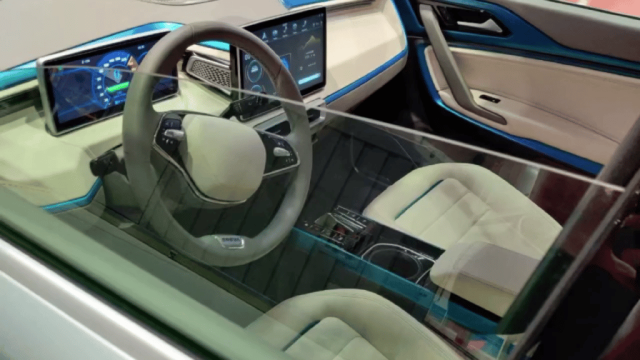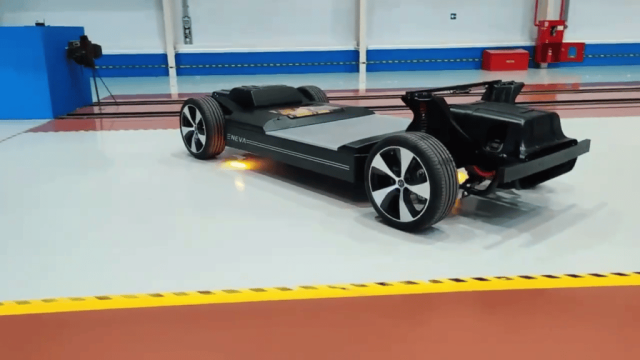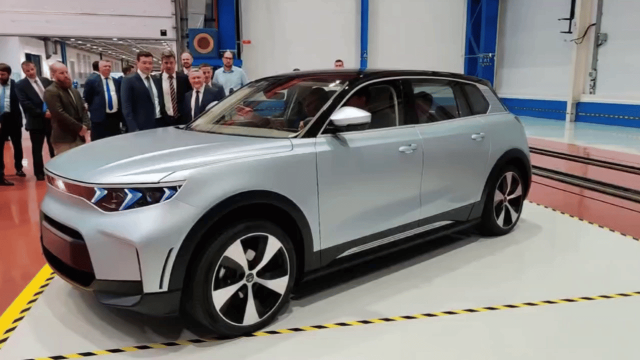It is claimed that the novelty will accelerate to a hundred faster than in three seconds, has the power of the "Tesla" class and a number of other good technical characteristics.
The Almaz-Antey defense concern presented the first prototype of its E-Neva electric car capable of movement to the head of the Ministry of Industry and Trade Denis Manturov. This is reported by the press service of the Ministry of Industry and Trade. The car looks noticeably more well-conceived than all the other samples of electric vehicles shown before in Russia (including the so-called electric "Moskvich"). At the same time, the ambitious nature of the project also means possible difficulties in its implementation in the series.
Back on July 15, 2022, during a meeting of the State Duma, at which Denis Manturov was approved as deputy prime minister, it was announced that electric vehicles are one of the promising areas of development of the Russian automotive industry. Apparently, to give some relevance to these statements, on July 16, during Manturov's visit to Nizhny Novgorod, he was shown an E-Neva. This electric car is being developed by the enterprises of the Almaz-Antey concern, which is mainly engaged in the production of weapons and military equipment.

It is clear from the interior that we are talking about a far from final version of the car
Image source: Wikimedia Commons
The running pattern of the car makes a mixed impression. It is known that its chassis was created by the Obukhov Almaz-Anteya plant, but the body was created by the St. Petersburg Polytechnic University. The chassis looks quite serious: with the total length of the car at 4.5 meters, there is a rather long wheelbase, which indicates the large size of the passenger compartment. Considering that the trunk capacity is stated to be 610 liters (that is, also significant), the crossover, despite its compactness, looks well conceived.
At the same time, its aerodynamic perfection should not be very high. It is unlikely that the drag coefficient there is lower than 0.26, and it is very likely that it is closer to 0.29. For comparison, the Model Y electric crossover has this coefficient of only 0.23. The designers also did not take advantage of such obvious drag reduction measures as replacing side mirrors with cameras or using more streamlined ("closed") wheels (like the same Tesla Model Y and Model 3).
It is claimed that the power reserve on a single charge of the car will be 463 kilometers with a battery capacity of 70 kilowatt-hours. This requires an energy consumption of only 15.12 kilowatt-hours per 100 kilometers, which is 10% lower than that of the Model Y. However, taking into account the aerodynamics of the E-Neva, it cannot be more energy efficient than the Model Y. Obviously, the mileage on a single charge for it is calculated not according to the EPA cycle, but according to the European WLTP. In this case, the actual mileage on a single charge will be around 400 kilometers, which, however, is also pretty good (at the level of the basic version of Model Y).

It is clearly visible that the overall layout of the platform repeats the Tesla concept: if possible, a flat battery, spaced throughout the bottom of the passenger part of the car
Image source: Wikimedia Commons
Earlier it was announced that the E-Neva has two electric motors (one on each axis), with a total power of 435 horsepower and a torque of 824 newton meters. They claim that this will be enough to accelerate to 100 kilometers per hour in 2.7 seconds. But, obviously, we are talking about time minus the scrolling of the wheels at the start. The launch of the machine in the series is expected in 2024. Perhaps it will be shifted to a later date, since we are talking about a full-fledged electric car with a large battery, and not alterations of internal combustion engines. Launching a series of such products, according to Tesla's experience, usually requires many years of work.
The interior of the car — apparently, this is more of a running layout than the final appearance of the prototype — is quite large and equipped with two screens, one of which is located in the center, and the second is in front of the steering wheel.
In recent months, information has been spreading that the car will also have a hybrid version. The hybrid is planned to be sequential (that is, the engine should charge the battery, not rotate the wheels), and the power reserve in this version will increase to 810 kilometers. This version of the car causes some confusion, because with 70 kilowatt-hours of batteries, the car should already be 20 thousand dollars more expensive than usual. Why to increase its price even by adding another internal combustion engine is not entirely clear.
At the same time, the development looks much more mature than the previously presented Russian electric vehicles. Including — and much more thoughtful than the "elektromoskvich", the analysis of which we recently devoted en/article/nakedscience/elektricheskij-moskvich" target="_blank" rel="nofollow">separate text . In contrast, the E-Neva has powerful motors that make it much more efficient to use regenerative braking, which increases mileage on a single charge.

